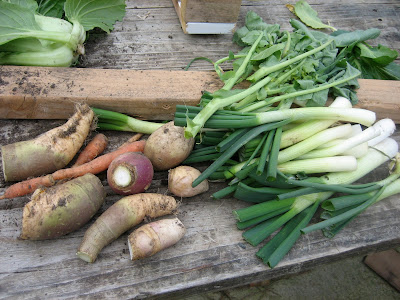Wow, two semi-sunny days in a row! This caused a kitchen remodel furlough. So we decided to prepare our beds, plant our seeds & transplant our starts.
Friday, we planted out our plot at the Orchard & Vine Community Garden.
We planted:
Sugar Lace Snap Peas (seed)
Cippolini & Red Onions (seed)
Early Jersey Wakefield Cabbage (transplant)
Lettuce- Bon Vivant Blend (seed)
Kohl Rabi- Purple Vienna (seed)
Today, we made a lot of progress at our home garden.
We pulled out most of the remnant veggies from our fall crop.
This is supposed to be a rutabaga. It was the largest one of the crop. We should have thinned out the seedlings.
Note: beautiful green leaves with no bulbous rutabaga... so sad. We could cook up the greens.
"Mine, all mine..."
We also pulled out the bulb onions that never quite formed bulbs last summer, but had nice greens. They would have flowered this spring, but we wanted the space for other things. So, we pulled them, cleaned them up and will use them for soups or stir fry. We also gleaned a few sad turnips, turnip greens, carrots, rutabagas, and a bok choy.
After we cleared the beds, we added some compost and turned it in.
Time to leave the nest, my little brassicas
In this bed, we planted brussels sprouts 'Roodnerf', cauliflower 'Early Snowball', Broccoli green and purple, and a red cabbage.
Since we didn't harden off our starts like we should have, we searched the basement for materials to make a plastic row tunnel. We had some random bits of PVC pipe and lots of plastic sheeting. This should do for a couple weeks until the transplants have acclimated to the outdoors.
In this bed, we transplanted chinese cabbage 'Winter Elf', red cabbage, and 'Early Jersey Wakefield' cabbage. Again we put up some plastic to help prevent transplant shock. Maybe Smithers will crawl in there and keep them warm.
We seeded this bed with lettuce and carrots. Our favorite carrot varieties have been 'Parisian Market' and 'Nantes Coreless'. We're trying "Little Finger" this year.
We transplanted the Sugar Snap Peas into the trellis bed.
We draped the plastic over the bed. To secure it we used sections of lath from our kitchen remodel to tack down the edges.
Grow Peas Grow!
I transplanted some chives that had grown into a big mess in the pea bed. We grew them from seeds a couple years ago. I moved them into an empty bed to give them more space. This is way more chives than any one household needs. Chives, anyone?
We planted Green Arrow Shelling Pea seeds in this bed. No plastic needed.
We got a lot done, but there's still much to do. Now, if only we could get a few more sunny days.




























